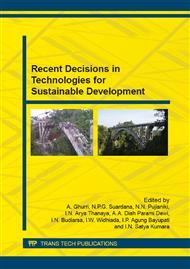p.313
p.319
p.325
p.331
p.337
p.343
p.349
p.355
p.361
Three Wheel Bike as Physical Therapy Equipment for Post-Stroke Patient
Abstract:
Three wheel bike as a physical therapy equipment for post-stroke patients was designed with length of 1937 mm, 1010 mm in width and height of 905 mm. The bike is designd ergonomic and can be driven by rider foot or hand simultaneously. By using CATIA software the strength of material bike frame was analyst to support 100 kg of load. The design is realized into a prototype. The performance of bike prototype is tested, and the result sows that the function of bike mechanisme is fulfilled. By 10 respondents, who have a standard body mass index, the pedal test was conducted, and the result indicates that, the higher the speed of the pedal, the higher the energy consumption to pedaling. Leg tension muscles is measured by leg-dynamometer before and after pedaling, and the result shows the tension muscle is proportional to the increase of pedal speed. In order to evaluate the ergonomic aspect of bike design, the risk angle of extrem position of body during cycling are measured by goneo-set. By RULA method the risk of injury value of rider body is calculated while pedaling, and the result showed that 70% of respondents have a value of risk injury 2, while 30% had a value of 3. It means that, the bike design is ergonomic and comfortable to ride. In oder to evaluate the benefits of disigned bike, the pedal test is conducted by 4 post-stroke patients for 30 days periodical once every 3 days. The result shows that during 1 month exercise, the average number of cycling to pedal increase up to 100%. This means that the ability of post-stroke patients to pedal the bike increase significantly. That result showed that the bike design is useful as a tool for physical therapy post-stroke patients.
Info:
Periodical:
Pages:
337-342
Citation:
Online since:
July 2015
Authors:
Price:
Сopyright:
© 2015 Trans Tech Publications Ltd. All Rights Reserved
Share:
Citation:


